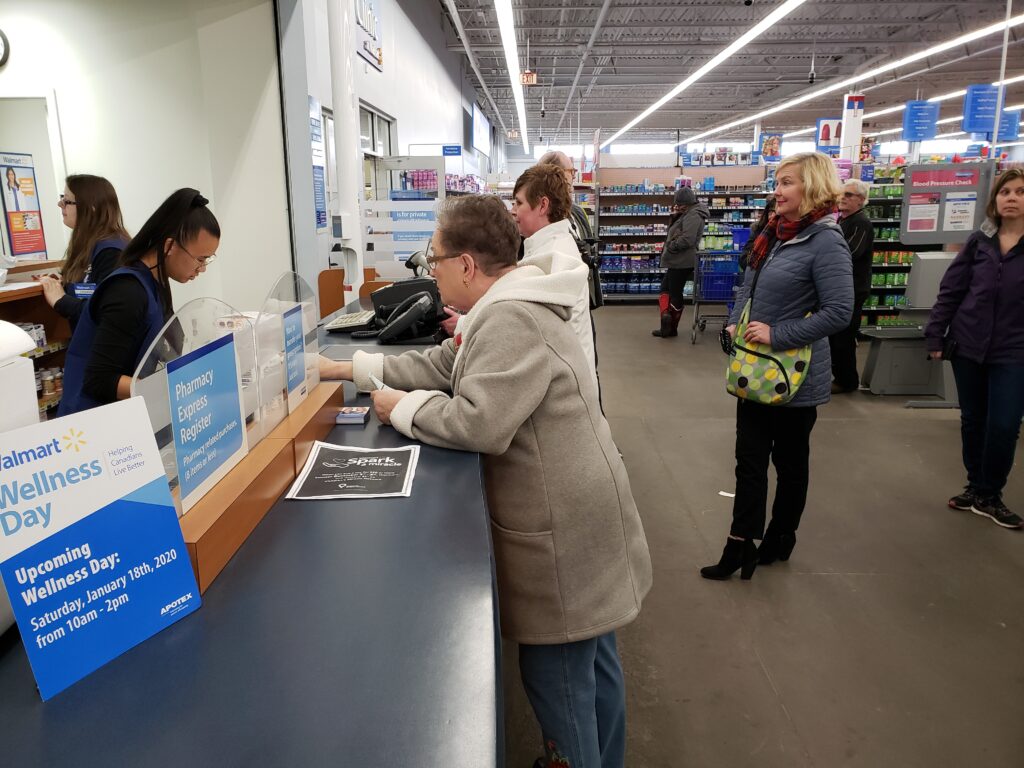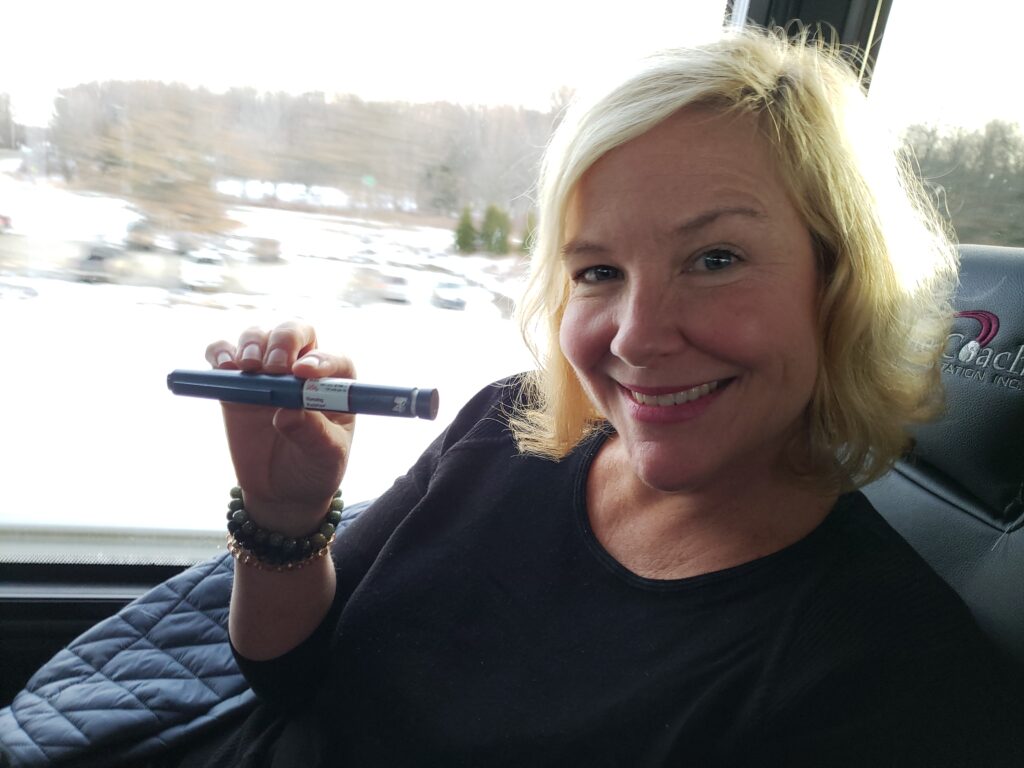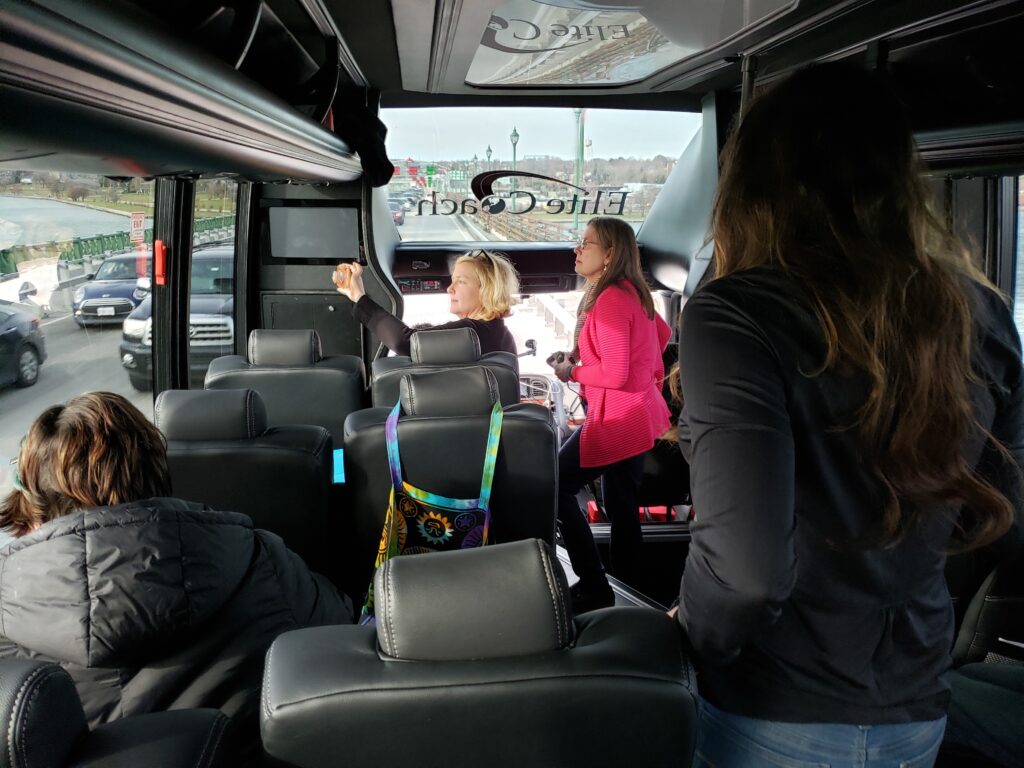MORGANTOWN — Judy Alexander rode the West Virginia Insulin Caravan to Niagara Falls, Canada, on Sunday. At the Walmart pharmacy counter, she paid less than half of what she pays at her Oak Hill, Fayette County pharmacy.
Her typical out of pocket for a three-month supply of two of three diabetes medications is $755. In Canada, she paid $311. That’s a savings of $444, or 59%.
She and her husband are both retired and rely on Medicare Part D for their prescriptions, she said.

“We thought we were set. We went onto Medicare thinking everything was OK. And that’s when these drug costs hit us. We have been blessed to be able to pay that amount. But, we can’t do that forever. Money runs out. We’ll just do what we have to do. “
She also made an observation about the absurdity of a pharmaceutical system that drives people to Canada. “I feel bad. I made my money in West Virginia, in the United States. Why do I have to go to Canada to spend it?”
The Insulin Caravan
Insulin caravans are becoming more common, with the price of Canadian insulin sometimes just 10% of the U.S. cost. And it’s much easier to obtain. You don’t need a prescription – except perhaps to get back across the border in case of U.S. Customs inquiries. And you can get a three month supply instead of the maximum one month or six week supply here.
Adrian Olmstead, president of the West Virginia chapter of Insulin4All, told Delegate Barbara Evans Fleischauer, D-Monongalia, about the caravans., Olmstead said. And Fleischauer ran with it from there. She worked with Delegate Jordan Hill, R-Nicholas and House Health chair, to organize this trip.

Thirteen people boarded the bus in Morgantown at 6 a.m. Sunday. Four intended to buy insulin. A couple came to see if they might in the future. The rest just came to observe and learn.
Buying the insulin at Walmart was easy. You just ask for it. If you call ahead of time, they can have it waiting.
So the only nail-biter was returning to the U.S. and going through Customs, because of vagaries in the law. We’ll get to that farther down.
Adrian Olmstead
Olmstead, of Morgantown, was diagnosed with Type 1 diabetes at age 11 and has lived with it for 34 years. She points out that only three companies make and supply insulin.
Sanofi makes Lantus, a once-per-day 24-hour insulin that maintains baseline levels. Lilly makes Humalog and Novo Nordisk makes NovoLog. Both control blood sugar spikes associated with meals and are typically injected three times a day.
There’s been no change in the formulas for the past 20 years, so the skyrocketing of prices from 2002 to now is inexplicable, she said.

Olmstead pays a $500 per month insurance premium plus about $200 per month for insulin, she said.
“That’s a pretty low number compared to what other people are paying, which is upwards of $1,000. … We’re being priced out of our lives.”
She observed that the rich can afford the huge copays, and the poor can use Mediciad. But the working folk in the middle are chiefly the ones who suffer from the high prices. It’s not uncommon across the nation for people to ration their insulin, and do without because they can’t afford it.
“There’s something really broken deep in the system making prices so high,” she said. “The rationing of insulin is killing people.”
Olmstead spent just over $300 U.S. for a three month supply, she said. Her ballpark outlay in Morgantown for six weeks is $300. So she got twice as much for the same price.
With the larger amount, she said, it gives her peace of mind knowing she has it stocked up.

“I think it’s maybe even going to change how I purchase insulin in the future. It’s not that long a trip up here, and I can buy three months’ worth. … It’s empowering.”
And future caravans might be worthwhile, she said.
Judy Alexander
Alexander injects NovoLog three times a day and Lantus at night. She also injects non-insulin Victoza, by Novo Nordisk, once a day. It helps lower A1C and blood sugar levels.
Victoza is the most expensive of her three medications, she said, but she couldn’t get any this trip because it requires a Canadian provider’s prescription.
Her monthly costs vary, she said, because of the Medicare donut hole. Copays are low up to a certain point, then rise once she hits the hole, then drop again when expenses hit the “catastrophic” level.
But this year, from Jan. 1 through Sept. 30 she’s paid $5,194.

Alexander retired after working in the healthcare field for 41 years, as an office manager and coder. Her husband retired three years ago from 50 years making mining equipment. She’s had Type 2 diabetes for 29 years.
At the start of 2018, with deductibles due, she said, she had tp pay out $3,700 in one shot. She had to put it on a credit card and pay that off in stages. Since they’ve retired, they can no longer pay into their health savings account, and have drained it.
While she’d prefer spending her money in West Virginia, she said, Canada is an option she’ll likely pursue. Her son lives in Pennsylvania and told her he’s willing to take her north when she needs to go, even to see a doctor to get a Victoza prescription.
Some didn’t buy
Two riders came thinking they would buy insulin, but didn’t.
Erin Noon, of Charleston, has Type 1 and said her three month supply costs $735, but her copay via her parents’ insurance is only $40. At Walmart, her total over-the-counter cost was $70.

A few observed the strangeness of that. The extra cost wouldn’t benefit her, but it’s more profitable for the insurance company to shell out nearly $700 here than to pay nothing in Canada.
Selina Vickers came to buy for her elderly parents, but there were some differences in the Canadian products and she didn’t feel they would be ready to deal with the change. But Canada remains an option for her.
Margaret Reider, a South Middle School teacher, rode the bus with her 17-year-old son, Roxy Vasil, who was diagnosed with Type 1 in first grade.
“We’re coming along just to see how it works, and would it work to our advantage to do this ourselves,” she said.
Her PEIA insurance covers quite a bit of Roxy’s expenses, she said, so she pays about $175 a month for both pens – the long-acting and the mealtime. “Which isn’t brutal.”
But to really control his A1C he also wears the FreeStyle Libre glucose monitor, from Abbott, on his arm. That’s another $135 a month out of pocket, she said. “That’s a lot of money for a teacher.”
On the ride back, she said she learned what she wanted: how easy it was to get in, get what they need and get out. “I don’t understand why more people aren’t doing this.”
She knows people who would benefit from coming to Canada for other medications, she said. “This could be an event that we do often. We all would reap benefits from doing it.”
Leaving Canada, and the future
“We wanted to show that you can do it if you want to,” Fleischauer said on the ride back. “It was nerve wracking but it was successful.”
The wracked nerves came from not knowing if U.S. Customs would seize the insulin, she said. Technically it’s illegal. But a convoluted, hard to understand paragraph of federal code appears to say Customs may not stop an individual who is not a professional importer from bringing in up to a 90-day supply of specified drugs for personal use.
Fleischauer said she consulted both of West Virginia’s U.S. senators about this, and their offices gave opposite answers about bringing it back. She also couldn’t get a consistent answer on whether the code applies to brining drugs back for a family member unable to travel.
As it turned out, Customs just reviewed everyone’s passports and waved the bus on.
But Fleischauer and Hill, she said, will be introducing a bill that may make future caravans irrelevant. It’s modeled on Colorado and Illinois legislation that caps insulin copays at $100. The West Virginia bill would cap them at $25.
Why the prices?
The American Diabetes Association offers some insight into the sky-high prices of insulin. Everything sited here is from its summary of a report by its Insulin Access and Affordability Working Group.
More than 30 million Americans live with diabetes. About 7.4 million use insulin. “The average list price of insulin has skyrocketed in recent years, nearly tripling between 2002 and 2013. The reasons for this increase are not entirely clear but are due in part to the complexity of drug pricing in general and of insulin pricing in particular.
“As the price of insulin continues to rise, individuals with diabetes are often forced to choose between purchasing their medications or paying for other necessities, exposing them to serious short- and long-term health consequences.”
In America, the insulin supply chain starts with the manufacturer – there are only three: Lilly, Sanofi and Novo Nordisk – and passes through wholesalers, pharmacy benefit managers (PBMs), insurers and pharmacies before reaching the patient. He various transactions escalate the price.
“With this system, there is no one agreed-upon price for any insulin formulation. The price ultimately paid by the person with diabetes at the point of sale results from the prices, rebates, and fees negotiated among the stakeholders.
“While the medication itself takes a rather direct path from manufacturer to wholesaler to pharmacy to patient, the flow of money is far less direct and transparent. Furthermore, PBMs often manage the pharmacy benefit portion of a health plan on behalf of their clients. … It is important to note, therefore, that PBMs’ primary customers are health plans and employers, not patients.
“It is clear that decisions made from negotiations between stakeholders that affect formulary choice may not be in the best financial or medical interest of the patient.”
Tweet David Beard @dbeardtdp Email dbeard@dominionpost.com




